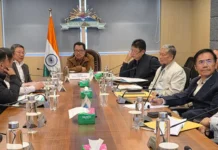NAMSAI, 24 Aug: A financial literacy camp-cum-jansuraksha saturation camp was held at the Town Club here on Sunday.
The initiative, organised by the Arunachal Pradesh Rural Bank (APRB), Namsai branch, in collaboration with the Arunachal State Rural Livelihoods Mission (ArSRLM) and the NABARD, saw the participation of self-help groups, community leaders, and local residents. It was aimed at deepening financial inclusion and empowering rural households.
The programme was part of a three-month nationwide campaign (1 July to 30 September), designed to expand the reach of flagship social security and financial inclusion schemes such as the Pradhan Mantri Jan Dhan Yojana (PMJDY), Pradhan Mantri Jeevan Jyoti Bima Yojana (PMJJBY), Pradhan Mantri Suraksha Bima Yojana (PMSBY), and Atal Pension Yojana (APY).
Addressing the participants, APRB Branch Manager Binalu Tayeng underlined the importance of social security schemes in securing the future of rural families.
NOSAAP CEO Chau Athina Chauhai highlighted the developmental activities being undertaken by them as farmer producer organisations (FPOs) with support from the government and the NABARD. He spoke about linking project families under the integrated tribal development projects with kisan credit cards (KCCs), and stressed the need for “quality agricultural inputs to ensure long-term success in farm and allied sectors.”
ArSRLM BMM Ronald Dakhar Baghwar reiterated the mission’s role in mobilising and handholding SHGs, PLFs, and CLFs, especially in bringing rural women under the umbrella of financial inclusion.
LDM Ojing Taboh explained the benefits of social security schemes like the PMJJBY, PMSBY, and APY, assuring participants of continued support as a bridge between banks and government departments.
Two members from Kampohini SHG and Roshni SHG shared their success stories, demonstrating how access to bank credit enabled them to start livelihood activities and become financially independent.
NABARD AGM Kamal Roy spoke on the broader role of banks in India’s financial system, emphasising the importance of savings, insurance, and investment. He reflected on the evolution of SHGs in rural ecosystems, while also cautioning against rising challenges posed by microfinance companies, online frauds, and Ponzi schemes.
Stressing the role of cooperatives, he described them as “the original platforms of collaborative work in villages, predating SHG federations and FPOs.”
District Planning Officer Dr Keshab Sarmahexplained the significance of bank accounts, direct benefit transfer (DBT), and the role of schemes like KCC in boosting farm incomes. He also encouraged the participants to replicate success stories from across the country in agriculture and allied sectors for better returns.
APRB Chairman Paogin Haokip provided an overview of the APRB’s role in rural banking. He assured enhanced support for credit linkages, MSMEs, handloom, and handicraft activities, in partnership with the NABARD, ArSRLM, NOSAAP, and SHGs. He noted that after the SBI, the APRB has emerged as the second-largest bank in Arunachal Pradesh in terms of ground-level credit flow and priority sector lending.
APRB Assistant Nelawati Namchoom also spoke.




